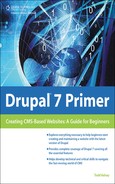Book Description
In the past, in order to make a website, you had to manually assemble all the files and develop a fair amount of technical expertise; however, an open source content management system (CMS) like Drupal can automate and significantly simplify many parts of the process. This book contains an easy-to-understand introduction to related concepts and a series of step-by-step examples that can help you learn how to use Drupal to create and maintain a website. The coverage also includes using a "quick-install" Web hosting account, which can greatly reduce the complexity of installing Drupal. You'll find that this book is written with beginners in mind; no prior expertise is required, except some familiarity with how to browse the Internet and use a PC. By the end of the book, you'll have a working knowledge of content management systems, installing and building a site in Drupal, and various Web promotion tactics that can help you share your new site with the world.
Table of Contents
- Copyright
- Acknowledgments
- About the Author
- Introduction
- Why CMS?
- Learning About Content Management Systems—Starting with Google Sites
- Exploring CMS: Showcase Sites, Live Demos, and Other Resources
- CMS Concepts—Visual Tour of a CMS-Based Site
- Getting Started—One-Click Installation
- Easy Security—Taming the Monster
- Introduction
- Meet Your Own Worst Nightmare
- Things You Can Do Other Than Dealing with Your Site (or Someone Else’s) Getting Hacked
- Signing Up for an Account on Drupal.org
- Subscribing to the Security Email List
- Checking on Updates, Updating a Module
- Typical “Open” Drupal versus Alternatives: Acquia and Google Sites
- Extra: A Way to Remember About Logging in—Google Calendar
- Conclusion
- Configuration
- Easy Content—Google Ajax Wizards
- Easy Information—Google Analytics
- Easy Administration—Ongoing Management
- Easy Expansion—Adding Content and Menus
- Modules to Simplify Content Creation
- Exploring Themes and Modules
- Promoting Your Site on Social Networks
- Promoting Your Drupal Site with Social Advertising
- Integrating Ecommerce: Google Checkout and Other Options
- Index
